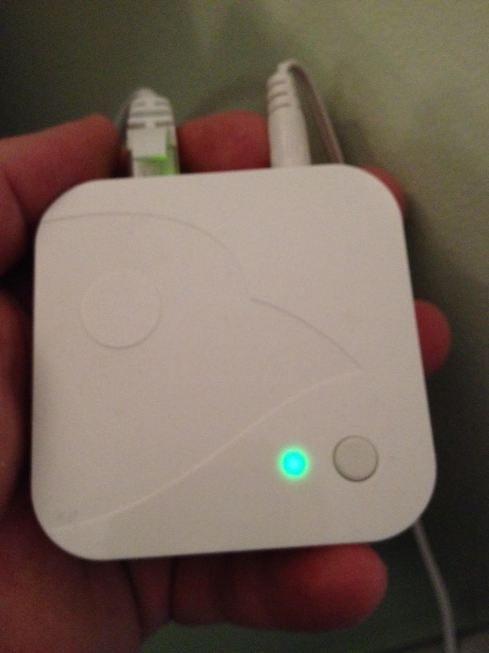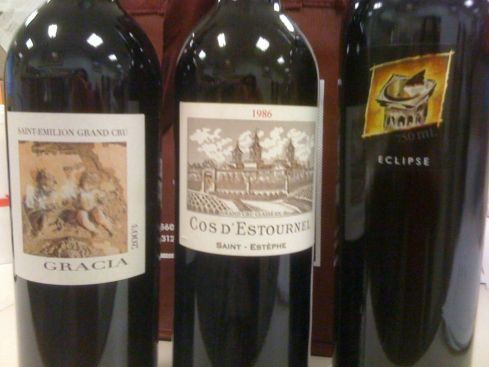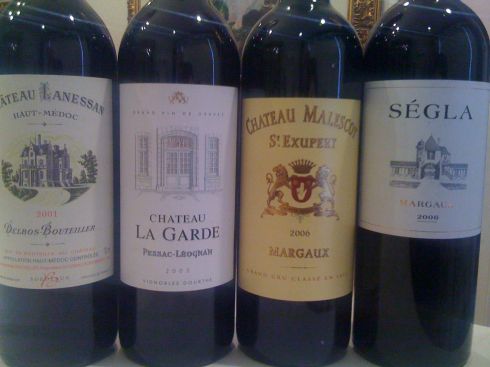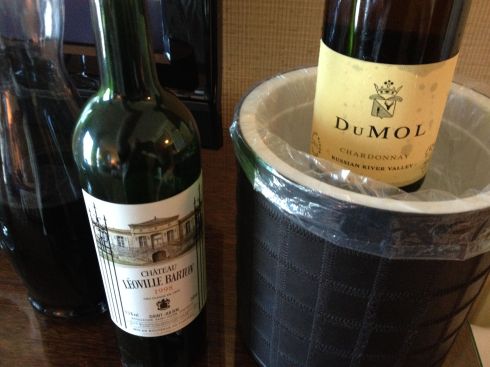Many oenophiles have both short term and long term locations for wine storage. Some years ago I learned a hard lesson by allowing some bottles to “cook” during an unexpected heatwave in my short term storage. I immediately started researching custom wine cellars. After finding I could not afford what I really wanted (a turn-key, custom-built, highly finished wine room), I then compromised significantly and built a humble, short-term wine storage cellar in my basement that maintained a very constant temperature and humidity, or so I thought.
Enter the Sensorist Monitoring System. The $200-ish package includes a ‘gateway’ that plugs into your home internet line and wirelessly communicates with monitoring devices: two temperature & humidity sensors and one additional thermometer-like probe you insert into a wine bottle (see below). Don’t fret at the European power adaptor, they include the correct type based upon your ship-to address.

Out of the packaging and powered up, the items look like this:



I set up the system, installing batteries as directed and and syncing the sensors with the gateway. While I downloaded the Sensorist app to my phone, I took the sensors to the cellar and placed them amongst cases of wine in the cellar. I set some alerts as per the instructions and started paying attention to what was actually happening in my wine storage. I ended up learning much more than I expected!
Among the things I’ve learned in the time I have had the Sensorist system:
1) I had no idea how much I needed this system. I’d previously been using a single thermometer/hygrometer, only checking it when I went to pull a bottle or to do rearrangements or inventory. The Sensorist app allows you to look at temperature and humidity currently, over the last last 24 hours, the last week, month, and year. It is a font of data I had no clue I needed. More importantly, it allows you to set alerts, to warn you when the temperature or humidity go above or below a range you set- which allows you to protect your wines, your investments, and your treasures.
2) Thanks to the data, I learned MUCH more than I expected. Not to anyone’s surprise, cellars are less consistent than you might think. Mine has areas that are consistent, some that vary, and like many homes, the temperatures increase vertically. I’ve ended up moving things around to protect the wines that need rest versus the ones I want to drink over the next few weeks.
Here’s some December data from the app; while it hovers around freezing outside, our home is 72° inside to keep my family toasty warm. In the warmest part of my cellar, it’s 60 degrees, and in the coolest part a humble 55 (measured from my old digital hygrometer/thermometer). The Probe is mid-way up my cellar, a good median measurement for me. These are taken two days apart:


3) Temperature probes are useful tools! Some cellar cooling systems use bottle probes to adjust their cooling mechanisms, and the data you get from inside the bottle is fascinating. There is less fluctuation inside the bottle than in air, but its important to weigh data from both the air and bottle. You can see that the probe’s temp is almost 4° cooler that the sensor it is attached to (which is at the highest point in my cellar), and in the image below, that the in-bottle probe stays very consistent while the air temp fluctuates during a weeklong period. This was a great thing for me to learn, to maintain the air temp but not to panic about minor fluctuation. It actually saved me in electrical costs by reducing the active cooling I do from fall to spring. You can also tell it’s the driest time of the year right now. I worry less about this because of the higher humidity I have ten months out of the year, and that I’m doing primarily short-term storage here.

4) The daunting cost simply isn’t. At first look, it felt pricey. Well, the actual cost of Sensorist is less than a great (or really good) bottle of wine, currently $199 plus shipping from Amazon or Wine Enthusiast, or €140 Euros plus VAT direct from Sensorist (approx $170 USD plus VAT and shipping). I find this a very small and reasonable investment when compared to the cost of tossing your favorite bottles. So it’s not about cost, it’s about value. Not only have I learned during the hottest part of summer and in the driest part of the winter how to protect my favorite treats and savory delights, but I have the alerts in place to insure that I know if anything goes awry.
5) Solid service. I experienced some unusual/spurious data in the use of my Sensorist monitoring system, so I reached out via email to the company. I received a prompt response, and new code was written to correct the anomaly. I felt that the company was concerned about and responsive to my needs, and committed to insuring that customers have a good experience with the product.
In conclusion, I didn’t know how much I needed this tool to maintain my wine storage until I had it. Now I know, and you do as well. Sensorist Wine Monitoring is a great tool for all- those with top of the line wine storage, and for the rest of us with more modest resources. It will allow you peace of mind to insure your favorite bottles will stay preserved until you are ready to uncork and enjoy them. Isn’t that what wine is all about?
à votre santé!
Tags: Cellar Tools, Sensorist Wine Monitoring, Wine Cellar, Wine Monitoring























Sensorist: The One Cellar Tool You Need, Right Now
30 DecMany oenophiles have both short term and long term locations for wine storage. Some years ago I learned a hard lesson by allowing some bottles to “cook” during an unexpected heatwave in my short term storage. I immediately started researching custom wine cellars. After finding I could not afford what I really wanted (a turn-key, custom-built, highly finished wine room), I then compromised significantly and built a humble, short-term wine storage cellar in my basement that maintained a very constant temperature and humidity, or so I thought.
Enter the Sensorist Monitoring System. The $200-ish package includes a ‘gateway’ that plugs into your home internet line and wirelessly communicates with monitoring devices: two temperature & humidity sensors and one additional thermometer-like probe you insert into a wine bottle (see below). Don’t fret at the European power adaptor, they include the correct type based upon your ship-to address.
Out of the packaging and powered up, the items look like this:
I set up the system, installing batteries as directed and and syncing the sensors with the gateway. While I downloaded the Sensorist app to my phone, I took the sensors to the cellar and placed them amongst cases of wine in the cellar. I set some alerts as per the instructions and started paying attention to what was actually happening in my wine storage. I ended up learning much more than I expected!
Among the things I’ve learned in the time I have had the Sensorist system:
1) I had no idea how much I needed this system. I’d previously been using a single thermometer/hygrometer, only checking it when I went to pull a bottle or to do rearrangements or inventory. The Sensorist app allows you to look at temperature and humidity currently, over the last last 24 hours, the last week, month, and year. It is a font of data I had no clue I needed. More importantly, it allows you to set alerts, to warn you when the temperature or humidity go above or below a range you set- which allows you to protect your wines, your investments, and your treasures.
2) Thanks to the data, I learned MUCH more than I expected. Not to anyone’s surprise, cellars are less consistent than you might think. Mine has areas that are consistent, some that vary, and like many homes, the temperatures increase vertically. I’ve ended up moving things around to protect the wines that need rest versus the ones I want to drink over the next few weeks.
Here’s some December data from the app; while it hovers around freezing outside, our home is 72° inside to keep my family toasty warm. In the warmest part of my cellar, it’s 60 degrees, and in the coolest part a humble 55 (measured from my old digital hygrometer/thermometer). The Probe is mid-way up my cellar, a good median measurement for me. These are taken two days apart:
3) Temperature probes are useful tools! Some cellar cooling systems use bottle probes to adjust their cooling mechanisms, and the data you get from inside the bottle is fascinating. There is less fluctuation inside the bottle than in air, but its important to weigh data from both the air and bottle. You can see that the probe’s temp is almost 4° cooler that the sensor it is attached to (which is at the highest point in my cellar), and in the image below, that the in-bottle probe stays very consistent while the air temp fluctuates during a weeklong period. This was a great thing for me to learn, to maintain the air temp but not to panic about minor fluctuation. It actually saved me in electrical costs by reducing the active cooling I do from fall to spring. You can also tell it’s the driest time of the year right now. I worry less about this because of the higher humidity I have ten months out of the year, and that I’m doing primarily short-term storage here.
4) The daunting cost simply isn’t. At first look, it felt pricey. Well, the actual cost of Sensorist is less than a great (or really good) bottle of wine, currently $199 plus shipping from Amazon or Wine Enthusiast, or €140 Euros plus VAT direct from Sensorist (approx $170 USD plus VAT and shipping). I find this a very small and reasonable investment when compared to the cost of tossing your favorite bottles. So it’s not about cost, it’s about value. Not only have I learned during the hottest part of summer and in the driest part of the winter how to protect my favorite treats and savory delights, but I have the alerts in place to insure that I know if anything goes awry.
5) Solid service. I experienced some unusual/spurious data in the use of my Sensorist monitoring system, so I reached out via email to the company. I received a prompt response, and new code was written to correct the anomaly. I felt that the company was concerned about and responsive to my needs, and committed to insuring that customers have a good experience with the product.
In conclusion, I didn’t know how much I needed this tool to maintain my wine storage until I had it. Now I know, and you do as well. Sensorist Wine Monitoring is a great tool for all- those with top of the line wine storage, and for the rest of us with more modest resources. It will allow you peace of mind to insure your favorite bottles will stay preserved until you are ready to uncork and enjoy them. Isn’t that what wine is all about?
à votre santé!
Share this:
Tags: Cellar Tools, Sensorist Wine Monitoring, Wine Cellar, Wine Monitoring